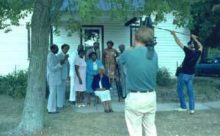Observations on Editing
The First Shot Means Everything
Opening scenes of a film frequently set the theme and tone for what follows. In finding our opening, we tried several possibilities. One of our favorite scenes is the singing of "Jezebel" by the Landis family men sitting in Bertha Landis's living room. They harmonize as Fleming Landis directs each vocal part for his younger brothers Claude and Tony (b. 1941), and his nephew Kenneth Daniel: "Jezebel…Jezebel …Jezebel." Then they start to sing. During the chorus, we added a voice-over from Bertha:
"They'd be upstairs in the bedroom singing and patting their feet over the top of our heads. And my husband would holler at them, 'Cut that fuss out!' and I'd say, 'Leave them alone. They'll be great singers some day!'"
"Jezebel" made an excellent opening. Viewers are immediately captivated by the strong performance and are asking questions that they expect the film to answer: These singers are great! Who are they? Where did they learn this song? What kind of song is it? Where is this?
 "Jezebel" focused the film squarely on the singers in the Landis family. With Bertha's voice-over, it suggested that the film would be about singing, and singers in a family. How did they become "great singers"? Who taught them? What does singing mean to them? Where do they sing today? Have they made any records?
"Jezebel" focused the film squarely on the singers in the Landis family. With Bertha's voice-over, it suggested that the film would be about singing, and singers in a family. How did they become "great singers"? Who taught them? What does singing mean to them? Where do they sing today? Have they made any records?
We tried "Jezebel" for the opening, but in the film that emerged from that beginning, it was hard to include as much of the family history as we wanted. Also, the expectations that "Jezebel" created made it difficult to present the experiences of the family's non-singing members such as Bertha's daughters Doshie Winston (b. 1920) and Jessie Mae Tharrington (b. 1923). The stories of these children, however, spoke richly to themes of twentieth-century African-American history that we wanted discussed: relations with white employers, migration to the north, finding marriage partners. The "Jezebel" beginning seemed more appropriate to the original, chiefly musical conception of the film.
An Alternative Edit That Worked
 In another scene that promised a strong beginning, Bertha Landis shows the camera a photograph of the family on her living room wall. The photo is in color and includes Bertha and her husband Coy surrounded by their eleven grown children. As the camera pans across the family, viewers hear Bertha counting the children, almost as if she can't quite believe there are so many. We cut to her talking:
In another scene that promised a strong beginning, Bertha Landis shows the camera a photograph of the family on her living room wall. The photo is in color and includes Bertha and her husband Coy surrounded by their eleven grown children. As the camera pans across the family, viewers hear Bertha counting the children, almost as if she can't quite believe there are so many. We cut to her talking:
"One, two, three, four, five, six, seven, eight. You know when I tell people I had eight boys, a lot of people didn't believe it. Eight boys and three girls. And I lost two girls. I'd of had five girls. Ain't that something and I'm still here. I don't know how I done it. I just don't know how. But the Lord was with me. He had to be."
This montage follows:
Cut to a dolly shot from a moving car: the countryside near the Landis homeplace.
Voice-over of Bertha leading the family in the spiritual "Union in Heaven."
Cut to Fleming Landis driving his family in the car and talking about returning every year for the family reunion.
Cut to Fleming and farnily arriving at the homeplace and greeting his mother Bertha.
Although this montage is neither as dramatic nor as musically entertaining as "Jezebel," it placed the emphasis where we needed it—on Bertha Landis and the family. It immediately presents the central elements and symbols of the film. Later, after viewers have heard Mrs. Landis's discussion of the "singing stream" in her family, "Jezebel" is performed. Now, however, the "Jezebel" performance is seen in the context of the family's experience.
 Other scenes unfold the years of struggle and the importance of family and religious faith to which Bertha alluded in the opening scene. The film's beginning also allows us to introduce, and easily return to later, the family reunion picnic that falls on the fourth Saturday of August. For this occasion family members gather at the homeplace from the surrounding community and from northern cities where several Landis children went during the 1940s to find employment. The film's closing scene, a living family portrait taken at the reunion, returns to the narrative frame which the opening scene has offered.
Other scenes unfold the years of struggle and the importance of family and religious faith to which Bertha alluded in the opening scene. The film's beginning also allows us to introduce, and easily return to later, the family reunion picnic that falls on the fourth Saturday of August. For this occasion family members gather at the homeplace from the surrounding community and from northern cities where several Landis children went during the 1940s to find employment. The film's closing scene, a living family portrait taken at the reunion, returns to the narrative frame which the opening scene has offered.
